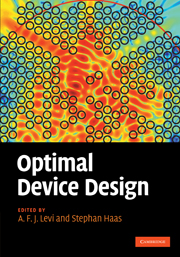Book contents
- Frontmatter
- Contents
- Preface
- Acknowledgements
- 1 Frontiers in device engineering
- 2 Atoms-up design
- 3 Electron devices and electron transport
- 4 Aperiodic dielectric design
- 5 Design at the classical–quantum boundary
- 6 Robust optimization in high dimensions
- 7 Mathematical framework for optimal design
- 8 Future directions
- Appendix A Global optimization algorithms
- About the authors
- Index
- References
5 - Design at the classical–quantum boundary
Published online by Cambridge University Press: 04 May 2010
- Frontmatter
- Contents
- Preface
- Acknowledgements
- 1 Frontiers in device engineering
- 2 Atoms-up design
- 3 Electron devices and electron transport
- 4 Aperiodic dielectric design
- 5 Design at the classical–quantum boundary
- 6 Robust optimization in high dimensions
- 7 Mathematical framework for optimal design
- 8 Future directions
- Appendix A Global optimization algorithms
- About the authors
- Index
- References
Summary
Introduction
In this chapter we explore systems whose description lies at the boundary between classical and quantum theory. There are of course many ways to approach this problem. Here, we choose to study the interaction of classical light with small metal particles of arbitrary shape. Specifically, we consider a physical model that is capable of observing the transition from bulk material properties to nanoscale structures, for which quantum effects dominate. We then explore the landscape of possible physical responses of such systems, using optimal design techniques to train our intuition.
The prevalent classical model describing the interaction of visible and infrared electromagnetic radiation with nanoscale metallic clusters is based on Mie theory [1]. This local continuum field model which uses empirical values of a bulk material's linear optical response has been used to describe plasmon resonances in nanoparticles [2–4]. However, such a semi-empirical continuum description necessarily breaks down beyond a certain level of coarseness introduced by atomic length scales. Thus, it cannot be used to describe the interface between quantum and classical macroscopic regimes. Moreover, extensions of Mie theory to inhomogeneous cluster shapes are commonly restricted to low-order harmonic expansions (e.g. elliptical distortions) and so do not exhaust the full realm of possible geometric configurations. In addition, near-field applications, such as surface enhanced Raman scattering [5], are most naturally described using a real-space theory that includes the non-local electronic response of inhomogeneous structures, again beyond the scope of Mie theory.
In the following section we describe a microscopic approach that demonstrates the breakdown of this concept at atomic scales, whereas for large cluster sizes the classical predictions for the plasmon resonances are reproduced.
- Type
- Chapter
- Information
- Optimal Device Design , pp. 123 - 148Publisher: Cambridge University PressPrint publication year: 2009



